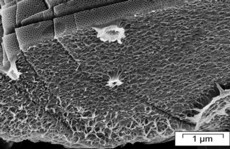Home > Press > Isoporous membranes of polystyrene-block-poly(ethylene oxide)
 |
Abstract:
The formation of isoporous membranes is a sensitive process dependent on molecular, solution, and processing parameters. Writing in the Journal of Polymer Science: Polymer Physics, Volker Abetz and colleagues use a combination of block self-assembly and phase inversion to prepare asymmetric membranes with highly ordered hexagonally packed cylinders composed of polystyrene-block-poly(ethylene oxide).
Isoporous membranes of polystyrene-block-poly(ethylene oxide)
Germany | Posted on November 24th, 2012The self-assembled nanostructured systems were a limiting factor in pharmaceutical and separation systems because of biofouling. Modifying the surface of the material with poly(ethylene oxide), they exhibit improved protein resistance, water solubility and blood compatibility. The advantages of the properties and self-assembly of polystyrene-block-poly(ethylene oxide) with the nonsolvent induced phase inversion for controlled orientation were combined to obtain the first integral-asymmetric membrane with an isoporous top layer.
"Our results provide a detailed insight in the structure formation of integral-asymmetric, isoporous membranes of polystyrene-block-poly(ethylene oxide). These were carried out via dynamic light scattering and cloud point determinations. Based on our results we successfully set parameters like non-solvent, solvent composition and evaporation time," says Abetz. "Poly(ethylene oxide) is widely known to prevent membrane biofouling. Furthermore it is proven to be biocompatible. For this reason these membranes offer a high potential for medical and biotechnological applications."
The interplay of the nonsolvent and the solvent system was evaluated and the selectivity of the solvent for individual blocks was adjusted. The structure formation is strongly influenced by the selection of the solvent system and the nonsolvent bath.
"Since this process is sensitive to a huge number of parameters, the challenge of our work was to investigate some of these parameters like evaporation time, polymer concentration and the solvent and non-solvent system. Therefore, we offer insight into the thermodynamic properties of the ternary system of the block copolymer, solvent and non-solvent system," explains Abetz.
Further research will focus on the study the structure formation of block copolymers of this type with various molecular weights and volume fractions. Furthermore the researchers plan to optimize the flux properties and to determine the fouling properties of these membranes over long periods of time.
####
For more information, please click here
Copyright © Wiley-VCH Materials Science Journals
If you have a comment, please Contact us.Issuers of news releases, not 7th Wave, Inc. or Nanotechnology Now, are solely responsible for the accuracy of the content.
| Related Links |
![]() Link to the original paper on Wiley Online Library:
Link to the original paper on Wiley Online Library:
| Related News Press |
News and information
![]() Simulating magnetization in a Heisenberg quantum spin chain April 5th, 2024
Simulating magnetization in a Heisenberg quantum spin chain April 5th, 2024
![]() NRL charters Navy’s quantum inertial navigation path to reduce drift April 5th, 2024
NRL charters Navy’s quantum inertial navigation path to reduce drift April 5th, 2024
![]() Discovery points path to flash-like memory for storing qubits: Rice find could hasten development of nonvolatile quantum memory April 5th, 2024
Discovery points path to flash-like memory for storing qubits: Rice find could hasten development of nonvolatile quantum memory April 5th, 2024
Self Assembly
![]() Liquid crystal templated chiral nanomaterials October 14th, 2022
Liquid crystal templated chiral nanomaterials October 14th, 2022
![]() Nanoclusters self-organize into centimeter-scale hierarchical assemblies April 22nd, 2022
Nanoclusters self-organize into centimeter-scale hierarchical assemblies April 22nd, 2022
![]() Atom by atom: building precise smaller nanoparticles with templates March 4th, 2022
Atom by atom: building precise smaller nanoparticles with templates March 4th, 2022
![]() Nanostructures get complex with electron equivalents: Nanoparticles of two different sizes break away from symmetrical designs January 14th, 2022
Nanostructures get complex with electron equivalents: Nanoparticles of two different sizes break away from symmetrical designs January 14th, 2022
Nanomedicine
![]() New micromaterial releases nanoparticles that selectively destroy cancer cells April 5th, 2024
New micromaterial releases nanoparticles that selectively destroy cancer cells April 5th, 2024
![]() Good as gold - improving infectious disease testing with gold nanoparticles April 5th, 2024
Good as gold - improving infectious disease testing with gold nanoparticles April 5th, 2024
![]() Researchers develop artificial building blocks of life March 8th, 2024
Researchers develop artificial building blocks of life March 8th, 2024
Discoveries
![]() Chemical reactions can scramble quantum information as well as black holes April 5th, 2024
Chemical reactions can scramble quantum information as well as black holes April 5th, 2024
![]() New micromaterial releases nanoparticles that selectively destroy cancer cells April 5th, 2024
New micromaterial releases nanoparticles that selectively destroy cancer cells April 5th, 2024
![]() Utilizing palladium for addressing contact issues of buried oxide thin film transistors April 5th, 2024
Utilizing palladium for addressing contact issues of buried oxide thin film transistors April 5th, 2024
Announcements
![]() NRL charters Navy’s quantum inertial navigation path to reduce drift April 5th, 2024
NRL charters Navy’s quantum inertial navigation path to reduce drift April 5th, 2024
![]() Discovery points path to flash-like memory for storing qubits: Rice find could hasten development of nonvolatile quantum memory April 5th, 2024
Discovery points path to flash-like memory for storing qubits: Rice find could hasten development of nonvolatile quantum memory April 5th, 2024
|
|
||
|
|
||
| The latest news from around the world, FREE | ||
|
|
||
|
|
||
| Premium Products | ||
|
|
||
|
Only the news you want to read!
Learn More |
||
|
|
||
|
Full-service, expert consulting
Learn More |
||
|
|
||








